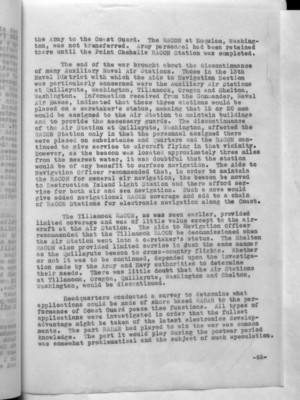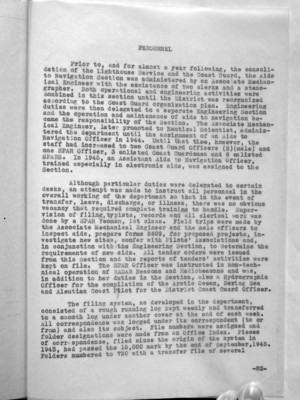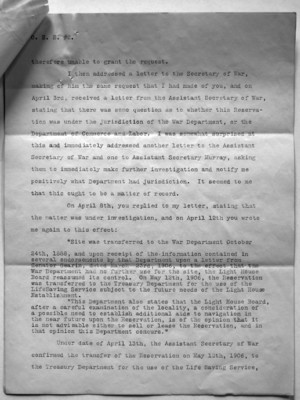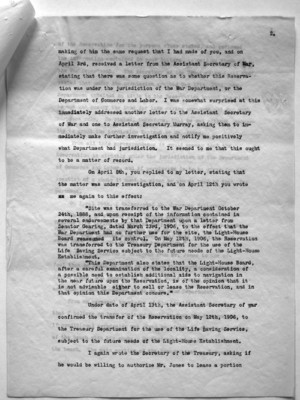Pages That Mention AIDS TO NAVIGATION
Coast Guard District narrative histories 1945
74
the patrol boats for more appropriate duties. The buoy was a first class tall type nun, painted white and lettered "A".
The first four obstruction buoys to be established in the District were placed at the Entrance to Port Townsend, Washington, to mark the Navy Submarine net a year before the war. Shortly afterwards, the Navy also established a magnetic survey range at Port Townsend and requested the Coast Guard to provide and plant four ice spar buoys there; funds for the transaction were provided by the Navy. This particular type of buoy, the ice spar, was selected because of its availability in the District, its length and its ability to remain vertical during any stage of the tide. These buoys were authorized by Headquarters but were never installed here as the magnetic survey range was moved to Point Jefferson and they were placed on station in that area shortly after the outbreak of the war. All these buoys had a buoyancy chamber at the low water flotation mark to keep them upright in deep water and they were moored with a chain pendant. This type also marked the range positions with the least swinging radius as the water was too deep for a fixed structure. Additional flotation chambers were provided for the lighted buoys to keep the buoy floating perpendicularly. The fog signal, however, was necessarily installed on a fixed structure.
Two Port Townsend Obstruction Lights ("A" and "D") were established in 1941, together with two unlighted Obstruction Buoys ("B" and "C"). Headquarters, in August of that year, approved the installation of Marrowstone Obstruction Light 1 and Point Hudson Dolphin Obstruction Light 2 at the entrance of Port Townsend Bay in Washington. Two other lights were authorized by Headquarters but were not installed as the need for them had decreased. In addition to these special aids to navigation, the Port Townsend area provided an obstruction lighted bell buoy, obstruction light and a lighted bell buoy. The Point Jefferson Degaussing Range included lighted spar buoys (12 were originally established but 2 were discontinued) a mooring buoy, placed on station there for small guard vessels.
These special RADAR calibration buoys were war measures and, though activities in this field were continued after the war, they were gradually reduced. The Degaussing Range, however, continued in operation at full strength, the Navy having informed the District Coast Guard Officer that the range would be necessary for at least a year after cessation of hostilities. These special aids, then, remained to the Coast Guard to service and maintain; one more activity added to its peace time function.
-54-
85
the Army to the Coast Guard. The RACON at Hoquiam, Washington, was not transferred. Army personnel had been retained there until the Point Chehalis RACON Station was completed.
The end of the war brought about the discontinuance of many Auxiliary Naval Air Stations. Those in the 13th Naval District with which the Aids to Navigation Section was particularly concerned were the Auxiliary Air Stations at Quillayute, Washington, Tillamook, Oregon and Shelton, Washington. Information received from the commander, Naval Air Bases, indicated that these three stations would be placed on a caretaker's status, meaning that 15 or 20 men would be assigned to the Air station at Quillayute, Washington, affected the RACON Station only in that the personnel assigned there were placed on subsistence and quarters and the RACON continued to give service to aircraft flying in that vicinity. However, as the beacon was located approximately three miles from the nearest water, it was doubtful that the station would be of any benefit to surface navigation. The Aids to Navigation Officer recommended that, in order to maintain the RACON for general air navigation, the beacon be moved to Destruction Island Light Station and there afford service for both air and sea navigation. Such a move would give added navigational RACON coverage and add a chain of RACON Stations for electronic navigation along the Coast.
The Tillamook RACON, as was seen earlier, provided limited coverage and was of little value except to the aircraft at the Air Station. The Aids to Navigation Officer recommended that the Tillamook RACON be decommissioned when RACON also provided limited service in much the same manner as the Quillayute beacon to cross-country flights. Whether or not it was to be continued, depended upon the investigation made by the Army and Navy authorities to determine their needs. There was little doubt that the Air Stations at Tillamook, Oregon, Quillayute, Washington and Shelton, Washington, would be discontinued.
Headquarters conducted a survey to determine what applications could be made of shore based RADAR to the performance of Coast Guard peace time functions. All types of applications were investigated in order that the fullest advantage might be taken of the latest electronics developments. The part RADAR had played to win the war was common knowledge. The part it would play during the postwar period was somewhat problematical and the subject of much speculation.
-65-
103
Prior to, and for almost a year following, the consolidation of the Lighthouse Service and the Coast Guard, the Aids to Navigation Section was administered by an Associate Mechanical Engineer with the assistance of two clerks and a stenographer. Both operational and engineering activities were combined in this section until the District was reorganized according to the Coast Guard organizational plan. Engineering duties were then delegated to a separate Engineering Section and the operation and maintenance of aids to navigation became the responsibility of the Section. The Associate Mechanical Engineer, later promoted to Nautical Scientist, administered the department until the assignment of an Aids to Navigation Officer in 1944. Until that time, however, the staff had increased to two Coast Guard Officers (R) (male) and one SPAR Officer, 3 enlisted Coast Guardsmen and 6 enlisted SPARS. in 1945, An Assistant Aids to Navigation Officer, trained especially in electronic Aids, was assigned to the Section.
Although particular duties were delegated to certain desks, an attempt was made to instruct all personnel in the overall working of the department so that in the event of transfer, leave, discharge, or illness, there was no obvious vacancy that required complete training to handle. Supervision of filing, typists, records and all clerical work was done by a SPAR Yeoman, 1st class. Field trips were made by the Associate Mechanical Engineer and the male officers to inspect aids, prepare forms 2609, for proposed projects, investigate new sites, confer with Pilots' Associations and, in conjunction with the Engineering Section, to determine the requirements of new aids. All tender orders were issued from this Section and the reports of tenders' activities were kept on file. The SPAR Officer was instructed in non-technical operation of RADAR Beacons and Radiobeacons and was, in addition to her duties in the Section, also a Hydrographic Officer for the compilation of the Arctic Ocean, Bering Sea and Aleutian Coast Pilot for the District Coast Guard Officer.
The filing system, as developed in the department, consisted of a rough running log kept weekly and transferred to a smooth log under another cover at the end of each week. All correspondence was logged under its correspondent (to or from) and also its subject. File numbers were assigned and folder designations were made from an Office Index. Pieces of correspondence, filed since the origin of the system in 1943, had passed the 15,000 mark by the end of September, 1945. Folders numbered to 730 with a transfer file of several -83
Correspondence of LH board 1901-1910
22
therefore unable to grant the request.
I then addressed a letter to the Secretary of War, making of him the same request that I had made of you, and on April 3rd, received a letter from the Assistant Secretary of War, stating that there was some question as to whether this Reservation was under the jurisdiction of the War Department, or the Department of Commerce and Labor. I was somewhat surprised at this and immediately addressed another letter to the Assistant Secretary of War and one to Assistant Secretary Murray, asking them to immediately make further investigation and notify me positively what Department had jurisdiction. It seemed to me that this ought to be a matter of record.
On April 8th, you replied to my letter, stating that the matter was under investigation and on April 12th you wrote me again to this effect:
"Site was transferred to the War Department October 24th, 1888, and upon receipt of the information contained in several endorsements by that Department upon a letter from Senator Gearin, dated March 23rd, 1906, to the effect that the War Department had no further use for the site, the Light House Board reassumed its control. On May 12th, 1906, the Reservation was transferred to the Treasury Department for the use of the LifeSaving Service subject to the future needs of the Light House Establishment.
"This Department also states that the Light House Board, after a careful examination of the locality, a consideration of a possible need to establish additional aids to navigation in the near future upon the Reservation, is of the opinion that it is not advisable either to sell or lease the Reservation, and in that opinion this Department concurs."
Under date of April 13th, the Assistant Secretary of War confirmed the transfer of the Reservation on May 12th, 1906, to the Treasury Department for the use of the Life Saving Service,
27
making of him the same request that I had made of you, and on April 3rd, received a letter from the Assistant Secretary of War, stating that there was some question as to whether this Reservation was under the jurisdiction of the War Department, or the Department of Commerce and Labor. I was somewhat surprised at this immediately addressed another letter to the Assistant Secretary of War and one to Assistant Secretary Murray, asking them to immediately make further investigation and notify me positively what Department had jurisdiction. It seemed to me that this ought to be a matter of record.
On April 8th, you replied to my letter, stating that the matter was under investigation, and on April 12th you wrote me again to this effect:
"Site was transferred to the War Department October 24th, 1888, and upon receipt of the information contained in several endorsements by that Department upon a letter from Senator Gearing, dated March 23rd, 1906, to the effect that the War Department had no further use for the site, the Light-House Board reassumed its control. On May 12th, 1906, the Reservation was transferred to the Treasury Department for the use of hte Life Saving Service subject to the future needs of the Light-House Establishment.
"This Department also states that the Light-house Board, after a careful examination of the locality, a consideration of a possible need to establish additional aids to navigation in the near future upon the Reservation, is of the opinion that it is not advisable either to sell or lease the Reservation, and in that opinion this Department concurs."
Under date of April 13th, the Assistant Secretary of war confirmed the transfer of the Reservation on May 12th, 1906, to the Treasury Department for the use of the Life Saving Service, subject to the future needs of the Light-House Establishment.
I again wrote the Secretary of the Tresury, asking if he would be willing to authorize Mr. Jones to leas a portion




